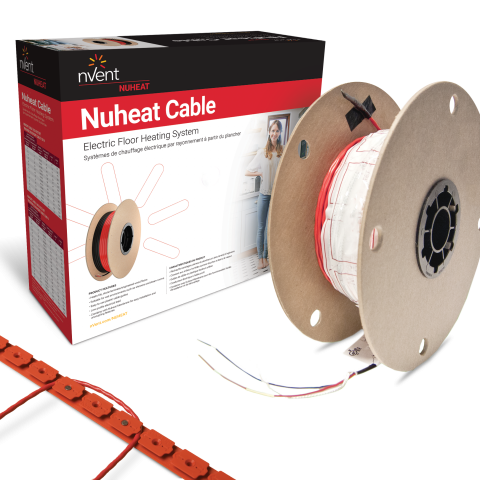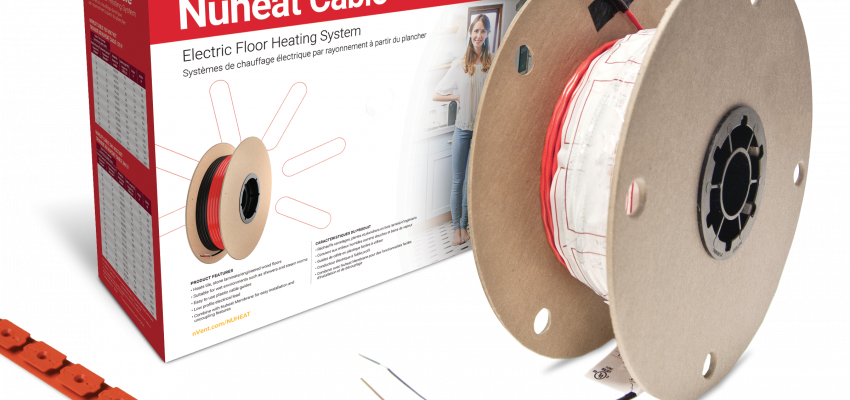Electric floor heating is becoming more popular all the time as a way to add comfort heating to select areas or even as a way to heat an entire home. There are many players on the market and it can be very difficult to discern the differences apart from the obvious: colours, brands, and price points. The NUHEAT brand has been making electric floor heating products since 1989. NUHEAT Mats are what made the nVent NUHEAT brand famous but Cable and Membrane is a popular option. nVent NUHEAT Cable sets the standard that other floor heating cables are judged by. The same quality, materials, and workmanship that goes into NUHEAT cable goes into MAPEI Mapeheat Cable.
Everybody’s cable has a different output; however, higher output does not equal better cable. It might be intuitive to say that hotter cable can be spaced more widely apart; therefore, you need less of it to cover a given area and that should be good… right? Not necessarily. Resistive heating is achieved by converting electrical energy to heat energy. By forcing enough electricity through the floor heating cable, we make it to heat up. It’s relatively easy to make a great conductor (conducts electricity, produces very little heat) or a great insulator (conducts very little electricity) but to making a great resistive heating cable with the right amount of heat output, long service life, excellent flexibility, consistent dimensional stability, and good mechanical durability is surprisingly difficult. All of these attributes are what make NUHEAT and Mapeheat Cable the industry benchmark.
The higher the specific heat output, the lower the expected lifetime of a resistive heater. Take the relatively extreme example of an old style incandescent light bulb. The filament in an incandescent light bulb is a resistive heater; it gets so hot that it glows! In order to give it a useful lifetime, the bulb is filled with inert gas so the filament doesn’t catch fire but even in that sterile environment, a typical incandescent bulb will only last about 1000 hours before it fails – that’s 125 days if used 8 hours per day. Another example, the heating element in a hot water heater, can be expected to last between 6 and 10 years before it burns out. NUHEAT Cable is designed to outlive its 25-year product warranty. NUHEAT has been producing resistive heating products for 31 years and counting and we know our product lasts because we’ve outlived our own warranty. Others, who have entered the market in the last 5 to 6 years knew they had to come close to matching our warranty benchmark to compete but their products don’t have our track record; regardless, this is a fact: if all other factors are equal, a hotter resistive heater will have a shorter lifespan but…
All other factors are not equal:
• NUHEAT Cable is very flexible while still maintaining excellent dimensional stability. This means it will not contract or expand significantly during heating cycles. Competing cable that does not have this high level of dimensional stability will have certain installation restrictions such as “tension loops” for runs straight runs that exceed 10 feet. NUHEAT Cable has no requirement for tension loops.
• Excellent dimensional stability means that the 25-year warranty applies even if the cable has to be repaired after damage during installation. Since the cable doesn’t expand and contract significantly, even multiple repairs along the same length do not lead to early failure later.
- Speaking of repairs, sometimes things happen on the job site. That said, cables with high mechanical durability, like NUHEAT Cable, are less likely to need a repair the next time a trowel fall on the floor. To be on the safe side, always use a NUHEAT Fault Detector during installation and repairs can be completed as soon as any damage occurs and before the floor coverings go down.
• Cables that run hotter than what is optimal have other installation restrictions such as minimum distance from a wall or other obstruction. NUHEAT Cable doesn’t have this restriction because its ideal heat output level ensures safe use, even right next to the bathroom wall and right up against the toe kick under the vanity. This helps to eliminate cold spots and even heat output is the most important factor in customer satisfaction with floor heating.
• NUHEAT cables are waterproof and UL approved for wet environments. Want to heat the shower floor? No problem. Waterproofing does not need to be installed above NUHEAT cable, keeping it as close as possible to the tile for ideal warmth (critical for shower bench tops – bums are sensitive!).
• The cold lead splice on NUHEAT cable is precision engineered to be both slim and robust. The slim profile enables it to be pressed into the NUHEAT Membrane without cutting or other modification, preserving the integrity of the membrane. Since splices are obvious possible failure points, the robust character of our splice is critical to the integrity of the cable and the proven long service life.
• NUHEAT Cable is approved for use below tile, stone, laminate, engineered wood, and luxury vinyl flooring without restrictive installation depths. Many competing cables can only be used under a small subset of these surfaces because they get too hot. Other competing products can only be installed with an installation depth that limits their effectiveness.
So, if you’ve ever asked yourself why NUHEAT Cable is sometimes more expensive than a competing alternative, the answer is simple: our cable is better and we have to make more of it to cover the same area because of its lower (aka ideal) heat output.


